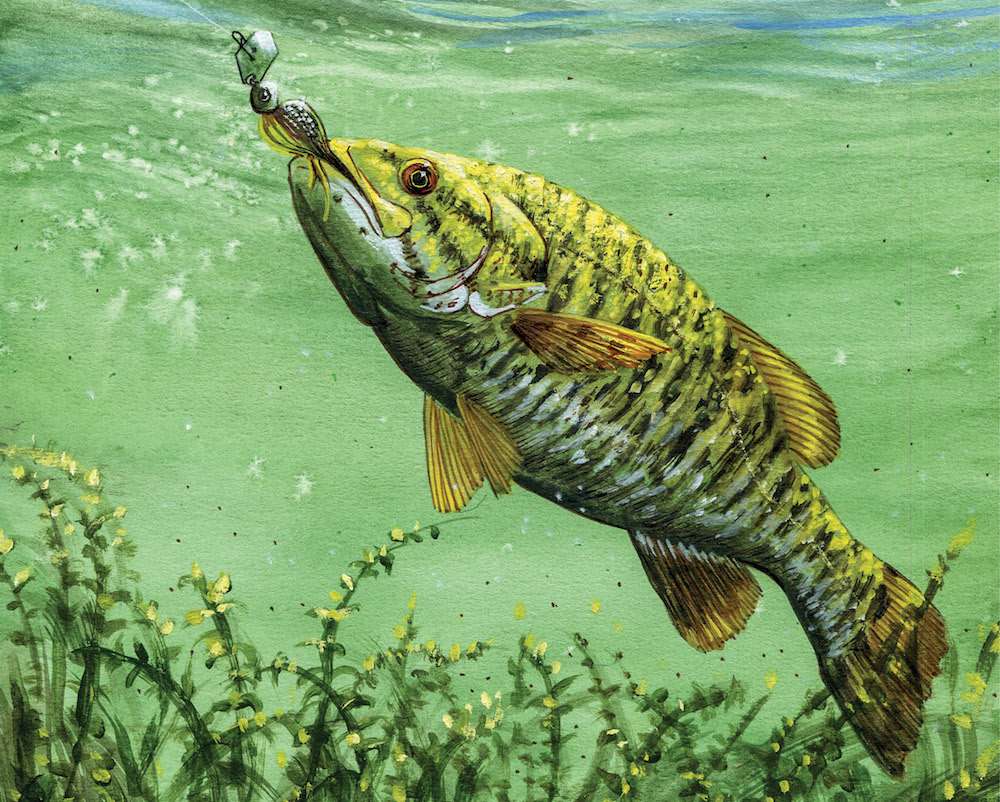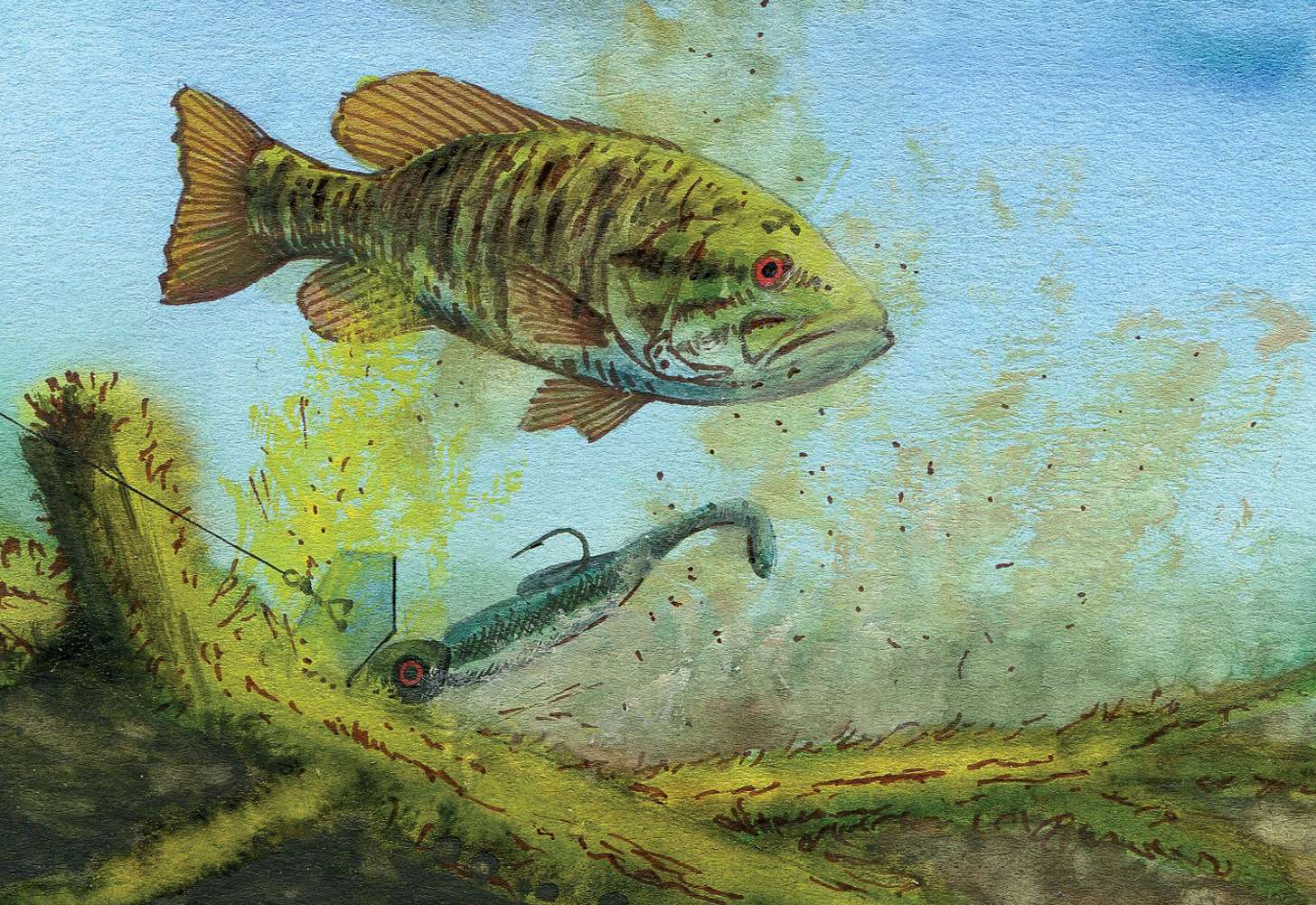
A plan is shared: Start with a jerkbait, and when the bite slows, switch to the follow-up. The face of a friend, visible over the phone in my mind’s eye, had an incredulous look. With a chuckle he replies, “That would be an obnoxious presentation!” Frankly, I understood where he was coming from. The follow-up was a rather thick profile for the clear, open waters prespawn smallmouth bass often roam. However, a ChatterBait speaks to large bass in a way some other baits simply do not.
The chatter on bladed jigs
Bladed jigs (or ChatterBaits) are an amalgamation of swim jig, spinnerbait and crankbait. Introduced to the bass fishing world approximately 16 years ago, they have earned notoriety as big-bass catchers and (unsurprisingly) gained in popularity in recent years. Several professional anglers swear by them (cheers, Brian Latimer), while companies and custom lure makers offer a variety of sizes and patterns.
Typical setup and presentation
I mentioned Latimer above. He is to the ChatterBait what David Fritts is to the crankbait: a master. After perusing YouTube videos of interest, usually featuring Latimer, I dedicated one of my setups as a ChatterBait rig. Typically, ChatterBaits work best when retrieved just above, below or along the weedline. This is certainly the case during my annual summer trips to Maine, where most of the quality largemouth (caught by my group) go for a 3/8-ounce bladed jig with a grub trailer.
A bulky profile and powerfully resonant blade vibration work well on the lateral line of any fish lying in wait. The flash thrown by most blades (some are painted for a subtler presentation) and ability to employ a variety of soft-plastic trailers (craws, swimbaits and grubs) ensure great visibility and versatility. Retrieve speeds can vary, but a slow retrieve (just fast enough to cause the bait to wobble) typically works best.
Most often, you will see casting rods as the primary option for bladed jigs. However, a spinning rod is also acceptable. With either rod type, the outfit requires strength and sensitivity. Though it’s generally weedless, you may have to pull the lure through vegetation. Of utmost importance is the power and speed (action) of the rod being paired with the appropriate line. A medium-heavy, fast rod paired with 15- to 17-pound fluorocarbon works extremely well for most conditions.
Prespawn smallmouth
In northern waters (such as the Catskills region of New York), the warming effects of spring signal the prespawn. As water temperatures move into the 40s (and low 50s), big girls move out of their wintering holes and start feeding in shallower water. The arduous task of piscatorial labor is about to begin. Females go on a caloric binge after the general austerity of winter, before the eggs start to drop. Even males have weight-gain goals to carry them through the period of defending the nest from would-be egg predators. Baitfish and crawfish hold a special place on the menu during the prespawn.
Without question, jerkbaits are a top lure choice for prespawn smallmouth. Whether you’re a tournament angler, TV personality or weekend warrior, it is an absolute go-to. The ability to impart erratic action (or a steadier retrieve) while keeping the bait in the strike zone for an extended period results in a great deal of success. For the past several years, my buddy had taken me to a location affectionately dubbed “Money.” The location may be public land surrounding public water, but it is special. The days I joined him on those shores have been equally so. Some of the largest smallmouth bass I have caught over the same time frame (of several years) have been caught while I was standing at “Money,” slinging a jerkbait.
New conversation
Back to the follow-up bait idea.
Unfortunately, my buddy was unable to make the trip this time around (May 2019). After securing his blessing, I went to “Money” for some prespawn action. They. Were. Hungry.
In less than one hour, 10 bass went for a jerkbait (Chasing Trophy Fish 4.5-inch EOC). For perspective, had it been in season, even the smallest bass was of legal size. More than satisfied with my morning (ecstatic is the appropriate word), the switch was made. After all, it had been five casts since the last bite. It was time for something new. A ChatterBait mimics baitfish and/or crawfish and offers a bulkier profile coupled with significant vibration — just the ticket.
I threw a 3/8-ounce bladed jig (crappie pattern) with a 4.5-inch PTL grub trailer (black and blue) on a medium-heavy fast action (Fenwick HMG) spinning rod. This pattern also resembled a major forage base in the water I was working: rainbow smelt. I downsized line test to 12-pound fluorocarbon (instead of 15- to 17-pound) since I was fishing open water. In general, lighter line has more flexibility and less memory and is less visible. Visibility concerns are minimized by the characteristics of fluorocarbon (having almost the same refraction point as water), but less is more in certain circumstances. I would not, however, reduce to anything below 12-pound test due to line-strength requirements.
Empirical victory
The new offering was immediately successful. The largest bass of the day to that point was the first landed using the ChatterBait. A few casts later, a personal best (lengthwise) found her way to the net; a personal goal was surpassed. Though the reputation as a primary option was proven on this day, these larger bass did not succumb to the jerkbait. The slow, steady retrieve and thumping vibration of the ChatterBait charmed them from their prespawn resting place.
The remainder of the day was spent slinging the ChatterBait, initially as a follow-up and then as a search bait in newly scouted locations. Strikes were triggered in each new parcel of water where fish were located, and other large bass were netted. As is often typical of fishing with a ChatterBait, quality reigns supreme over quantity. Though not subtle, maybe the presentation was not that obnoxious.
Do not be afraid to try something new. Tight lines.

B-Lat’s Trailer Selection
Trailer selection has a direct relationship to action and depth. Latimer uses many soft-plastic trailers from Z-Man but highlighted the following three:
- Razor ShadZ (center — the slim profile works well through hydrilla and in deeper water)
- DieZel MinnowZ (right — a paddletail swimbait that causes a great deal of water displacement and works well in shallower water)
- Turbo CrawZ (left — a visual bait with a lot of action that works very well high in the water column)
Reel Choice
Rod selection is conditional/situational, but always use a slower reel with power. Brian Latimer uses a 6.8:1 Lew’s Tournament Pro spooled with fluorocarbon line.
Rod Selection
A medium power rod with a slow action works best for ChatterBaits. Latimer uses a 7-foot, 2-inch Favorite Rigged series graphite rod when fishing grass and a 7-foot, 4-inch Favorite Fat Glass series rod for open water or woody cover.

B-Lat’s Top Retrieve
A ChatterBait is an impact bait. During the retrieve, make contact whenever possible with cover or structure, similar to a crankbait. Also, ChatterBaits make a great mud trail when retrieved along the bottom.
Don’t overwork it. Allow your rig, trailer and ChatterBait to do their thing.
Originally published in Bassmaster Magazine 2020.




